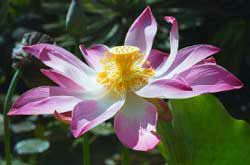Centuries Later, Chinese Lotus Seeds Still Sprout

Nearly 500 years after forming in their parent plant, lotus seeds from a Chinese lakebed have sprouted seedlings of their own, researchers say. According to the lead author of a study detailing the findings, published in the current issue of the American Journal of Botany, the cultivation of offspring from seeds this ancient is “a first in plant biology.”
Biologist Jane Shen-Miller of the University of California, Los Angeles, and colleagues collected 20 ancient lotus seeds on a trip to China’s Liaoning Province. Radiocarbon dated at between 200 and 500 years old, the four seeds that the team tested for viability all sent up shoots. But the plants have not fully escaped the effects of time: all exhibit abnormalities in their leaves, stalks and underground stems. “Instead of standing up straight with strong leaves, these were smaller, the leaves were weak and bent, displayed abnormalities in color, and the underground stems were small and not getting enough food,” Shen-Miller reports. The culprit, she surmises, is long-term, low-dose radiation from the soils in which the seeds resided. (The lotus pictured at the right did not arise from the seeds discussed here.)
Still, the radiation exposure does not appear to have hampered germination. “The lotus is so robust that it can sprout after centuries of exposure to low-dose gamma radiation,” Shen-Miller observes. “We need to learn about its repair mechanisms, and about its biochemical, physiological and molecular properties. The repair mechanisms in the lotus would be very useful if they could be transferred to crops, such as rice, corn and wheat, whose seeds have lifespans of only a few years.”
Media Contact
All latest news from the category: Life Sciences and Chemistry
Articles and reports from the Life Sciences and chemistry area deal with applied and basic research into modern biology, chemistry and human medicine.
Valuable information can be found on a range of life sciences fields including bacteriology, biochemistry, bionics, bioinformatics, biophysics, biotechnology, genetics, geobotany, human biology, marine biology, microbiology, molecular biology, cellular biology, zoology, bioinorganic chemistry, microchemistry and environmental chemistry.
Newest articles

Webb captures top of iconic horsehead nebula in unprecedented detail
NASA’s James Webb Space Telescope has captured the sharpest infrared images to date of a zoomed-in portion of one of the most distinctive objects in our skies, the Horsehead Nebula….

Cost-effective, high-capacity, and cyclable lithium-ion battery cathodes
Charge-recharge cycling of lithium-superrich iron oxide, a cost-effective and high-capacity cathode for new-generation lithium-ion batteries, can be greatly improved by doping with readily available mineral elements. The energy capacity and…

Novel genetic plant regeneration approach
…without the application of phytohormones. Researchers develop a novel plant regeneration approach by modulating the expression of genes that control plant cell differentiation. For ages now, plants have been the…





















